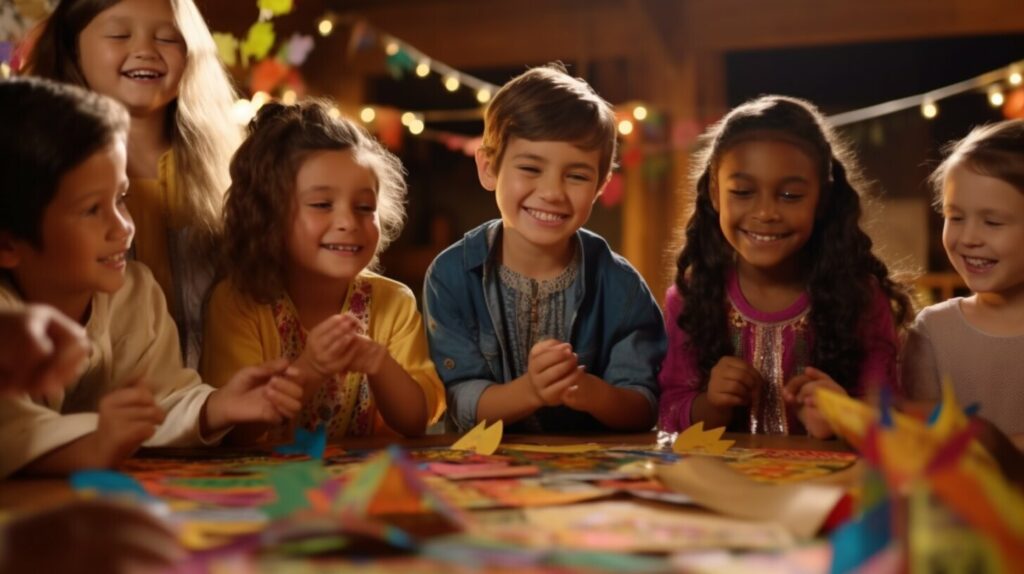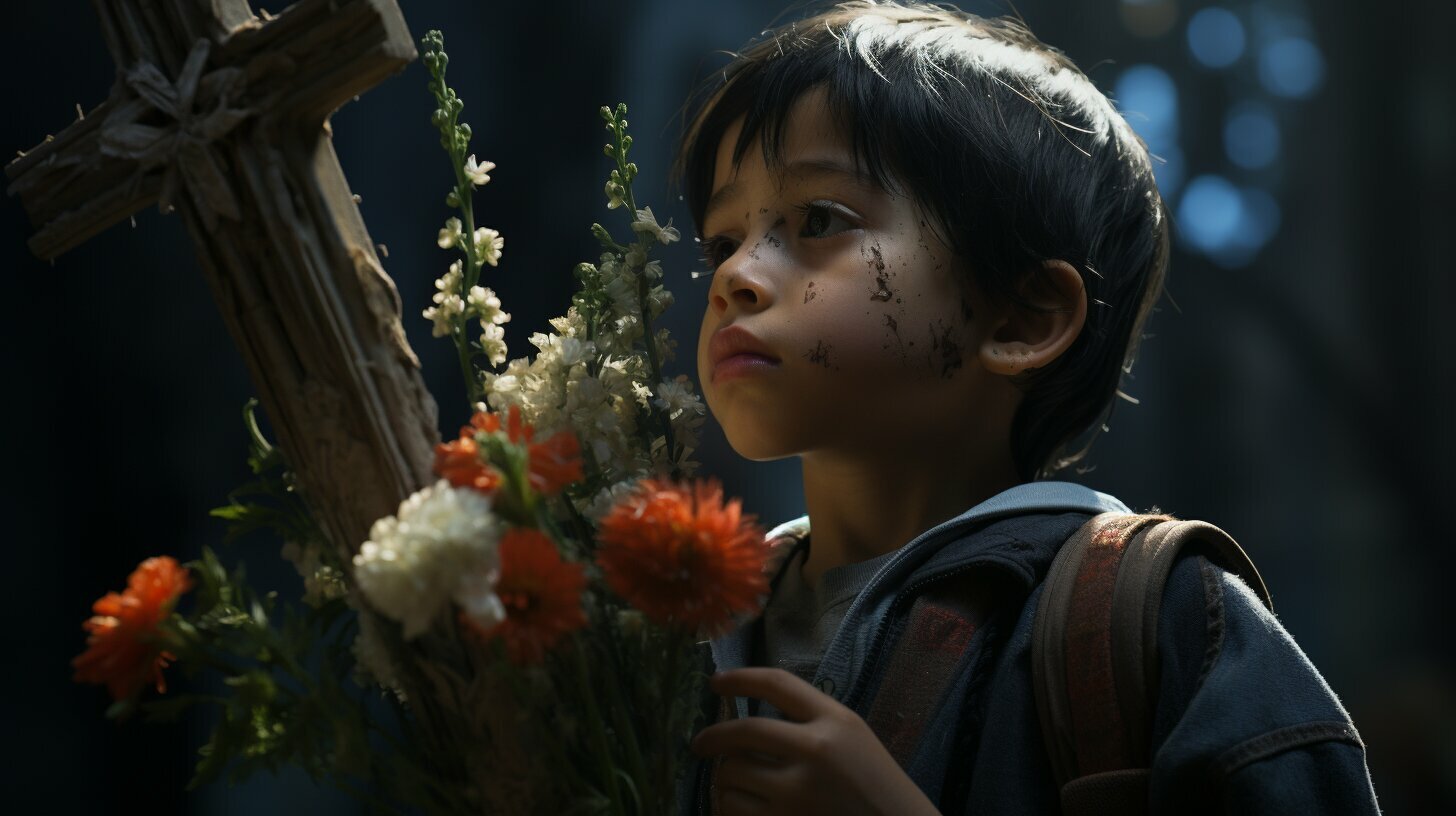As a parent, you want to share your favorite holidays with your child, but you might not want to rely on religious explanations. Explaining holidays to your child without religion is possible and can provide an opportunity to embrace different cultures and beliefs. In this article, we will share tips and ideas for engaging your child in non-religious holiday discussions.
Key Takeaways:
- Creating inclusive celebrations that embrace different cultures and beliefs is important.
- Teaching children about holidays from a secular perspective promotes tolerance and diversity.
- Exploring cultural celebrations through crafts, food, or community events can be an exciting way to teach children about holidays without focusing on religion.
Teaching Children about Holidays: A Secular Approach
As a parent, it’s important to teach your child about different holidays and cultural celebrations. Understanding different traditions and customs is essential for promoting tolerance and diversity. By taking a secular approach, you can provide your child with non-religious explanations of holidays.
One way to teach your child about holidays is to use age-appropriate resources. Books, websites, and educational videos can offer non-religious explanations of different holidays. For example, you can read books that explain the origins of Halloween, Thanksgiving, or the Fourth of July, without emphasizing any religious beliefs.
Another way to approach teaching your child about holidays is to explore cultural celebrations. You can discuss the significance of different festivals and traditions, such as Chinese New Year, Diwali, or Cinco de Mayo. Engage your child in learning about these celebrations through crafts, food, or community events. This can help your child gain a better understanding and appreciation of different cultures.
It’s important to emphasize the historical and cultural aspects of holidays, rather than religious connotations. For example, you can explain the origins of Christmas, Easter, or Hanukkah without focusing on their religious significance. This can help your child understand the seasonal or historical connections to these holidays.
By taking a secular approach to teaching your child about holidays, you can create inclusive discussions that welcome everyone, regardless of their religious beliefs. You can incorporate diverse traditions and customs into your family’s celebrations, and encourage open discussions about the values that holidays promote, such as gratitude, kindness, or generosity.

In summary, it’s important to take a secular approach when teaching your child about holidays. By using age-appropriate resources, exploring cultural celebrations, emphasizing historical and cultural aspects, and creating inclusive discussions, you can help your child gain a better understanding and appreciation of different traditions and customs. Doing so will foster tolerance and diversity, and help your child become a more thoughtful and empathetic individual.
Exploring Cultural Celebrations with Children
One of the best ways to teach children about holidays without relying on religion is to explore the cultural celebrations of different communities. It can be a fun and enlightening experience for both you and your child to learn about the rich traditions that make up our diverse world.
There are many cultural celebrations to choose from, such as Chinese New Year, Diwali, or Thanksgiving. You can start by discussing the origins and significance of each festival, and what it means to the people who celebrate it.
One way to engage your child in learning about these celebrations is through crafts. For example, you can make Chinese lanterns for Chinese New Year, or create Rangoli designs for Diwali. Encourage your child to explore different materials and colors, and to be creative in their designs.
Another way to learn about cultural celebrations is to attend community events. Many cities and towns hold festivals and parades that celebrate different traditions. You can also visit museums or cultural centers that offer exhibits and workshops on different cultures.
| Tip | Activity |
|---|---|
| Tip #1: | Research and discuss the cultural significance of different holidays together. |
| Tip #2: | Create crafts or artistic projects that relate to the cultural celebrations. |
| Tip #3: | Attend community events that celebrate different traditions and cultures. |

Learning about cultural celebrations can help children develop a sense of empathy and appreciation for different ways of life. By exploring and celebrating diversity, we can foster a more inclusive and accepting society.
Non-Religious Holiday Explanations for Kids
When it comes to explaining the meaning and history of popular holidays to your child, you may feel unsure about how to approach the subject without relying on religious beliefs. However, it is possible to offer non-religious holiday explanations that focus on the cultural, historical, or seasonal aspects of these celebrations.
For example, when talking about Christmas, you can emphasize the tradition of gift-giving, which originated from the story of St. Nicholas, a generous bishop who gave presents to poor children. You can also discuss the origins of Christmas as a pagan festival celebrating the winter solstice and the return of sunlight. Additionally, you can explore the cultural significance of Christmas symbols, such as the Christmas tree, wreaths, and lights.
Similarly, when discussing Easter, you can explain the tradition of egg hunting, which symbolizes the new life and rebirth associated with spring. You can also delve into the history of Easter as a Christian holiday commemorating the resurrection of Jesus, while acknowledging that different cultures have their own unique ways of celebrating this time of year.
By offering non-religious holiday explanations, you can help your child appreciate the diversity and richness of different cultures, while also fostering critical thinking and cultural understanding.

Creating Inclusive Holiday Celebrations
As a parent, it is crucial to create an inclusive holiday celebration that welcomes everyone, regardless of their religious beliefs. By doing so, you can foster a sense of togetherness, promote cultural understanding, and respect diversity. Here are some tips on how to create a non-denominational holiday celebration:
- Embrace different beliefs: Encourage your child to learn about different holiday traditions and customs. Discuss the significance of each celebration and highlight the values they promote, such as love, kindness, or compassion.
- Incorporate diverse decorations: Choose decorations that represent different cultures and traditions, such as a menorah, a Christmas tree, or a kinara. Display them in a way that celebrates diversity and promotes unity.
- Create inclusive activities: Plan activities that are inclusive and fun for everyone. For example, you could organize a gift exchange, a potluck dinner, or a holiday craft project that highlights different cultural traditions.
- Encourage open discussions: Create a safe space for your child to ask questions and share their thoughts and feelings about the holidays. Teach them to be respectful and empathetic towards others’ beliefs and traditions.
- Focus on community: Encourage your child to participate in community events and activities that celebrate diversity. Attend parades, festivals, or concerts that embrace different cultures and traditions.
By creating an inclusive holiday celebration, you can teach your child to value diversity, promote cultural understanding, and foster empathy and tolerance towards others. Remember, the holidays are a time for togetherness and kindness, and we can all celebrate them together!

Emphasizing the Spirit of Giving
One of the most important aspects of holiday celebrations is the spirit of giving. Teaching children about generosity and compassion is a valuable lesson that can last a lifetime. There are many ways to incorporate this message into your family’s holiday traditions.
An excellent way to involve your child in charitable activities is by volunteering your time at a local organization. From serving meals at a soup kitchen to visiting a senior center, there are many opportunities to give back to the community.
Donating toys or food to those in need is another way to teach children about the importance of giving. You can encourage your child to choose age-appropriate items to donate to a local charity or shelter. Writing cards or letters to those who may be feeling lonely or isolated during the holiday season is also a thoughtful gesture.
Remember, the spirit of giving is not limited to material possessions. Encouraging your child to perform random acts of kindness, such as holding the door open for someone or complimenting a stranger, can also have a positive impact.
It’s important to emphasize that the values of compassion and empathy are universal and not tied to any particular religious tradition.

Exploring Nature’s Cycles and Seasons
Many holidays are rooted in nature’s cycles and seasons, from the harvest festivals of autumn to the spring equinox celebrations. Exploring these connections can be a fun and educational way to teach children about different holidays without relying on religious explanations.
You can start by taking your child on a nature walk and pointing out the changes that occur throughout the year. Ask them to observe the colors, smells, and textures of different plants and trees, and explain how they relate to the changing seasons. You can also do some simple gardening with your child, planting seeds in the spring and watching them grow throughout the summer.
Another fun activity is creating seasonal crafts with natural materials, such as leaves, acorns, or pinecones. You can help your child make a leaf garland for autumn, a wreath of flowers for spring, or a snowflake ornament for winter.
| Tip: | Introduce your child to the concept of solstices and equinoxes, and explain how they mark the changing of the seasons. You can use a simple diagram or illustration to show the tilt of the Earth’s axis and how it affects the amount of daylight in different parts of the world. |
|---|
Connecting holidays to nature can also help foster a sense of environmental awareness and responsibility in your child. You can discuss the importance of conservation, recycling, and sustainable living, and how these practices relate to the natural world.

By exploring nature’s cycles and seasons, you can help your child appreciate the beauty and diversity of the natural world, while also teaching them about the cultural significance of different holidays.
Encouraging Critical Thinking and Cultural Understanding
Explaining holidays to children without relying on religious beliefs can provide an excellent opportunity for fostering critical thinking and cultural understanding. Encourage your child to ask questions and explore the cultural and historical contexts behind different traditions. By doing so, they develop tolerance, respect, and empathy for people with different beliefs and cultures. Here are some ideas to help you encourage critical thinking and cultural understanding during holiday discussions:
- Ask open-ended questions: Instead of simply explaining the meaning of a holiday, ask your child questions that encourage them to think critically and creatively. For example, you could ask, “What do you think people do during this holiday? Why do you think they do it?” This kind of open-ended questioning can lead to deeper discussions and insights.
- Research together: Use books, documentaries, or online resources to research the history and cultural significance of different holidays. By doing so, you and your child can discover fascinating facts and stories that help you to understand the roots of different traditions better.
- Compare and contrast: Engage your child in discussions that compare and contrast different celebrations and customs. You could compare Christmas and Hanukkah or explore the differences in how Easter is celebrated in different cultures. By doing so, you can highlight the diversity of experiences and beliefs that exist in the world.
- Share your own experiences: Share your own memories and experiences of holidays from your childhood or your experiences celebrating different traditions. By doing so, you can help your child to understand the cultural significance of different holidays and appreciate the diversity of people’s experiences and beliefs.
By encouraging critical thinking and cultural understanding, you can help your child to develop valuable skills and attitudes that will serve them well throughout their lives.

Conclusion
Explaining holidays to children without religion can be an exciting and fulfilling experience that promotes cultural understanding, empathy, and appreciation for diversity. By teaching your child about holidays from a secular perspective, you can help them become more tolerant, curious, and open-minded individuals.
Remember, creating inclusive holiday celebrations that welcome everyone is essential, regardless of their religious beliefs. You can achieve this by incorporating diverse traditions and customs into your family’s celebrations, encouraging open discussions, and emphasizing universal values, such as compassion, kindness, and generosity.
Don’t forget to explore nature’s cycles and seasons and connect holidays to the natural world. By doing so, you can help your child gain a deeper appreciation for the beauty and diversity of our planet, and foster important critical thinking skills and cultural understanding.
So take the time to engage your child in non-religious holiday discussions, and encourage them to ask questions, research, and explore different cultural celebrations. By doing so, you can help them develop a broader, more inclusive perspective on the world, and become more compassionate and empathetic individuals.
How Can I Explain Religious Holidays to Kids without Using the Bible?
When it comes to explaining religious holidays to kids without using the Bible, there are alternative ways to engage them in learning. One tip is to focus on the cultural and historical aspects of the holiday, emphasizing its traditions, symbols, and stories. Additionally, you can introduce age-appropriate books, videos, or interactive activities that provide context and engage their imagination. By incorporating these tips for engaging kids with bible explanation, you can create a meaningful and inclusive experience for them.
FAQ
Q: How do I explain holidays to my child without religion?
A: Explaining holidays to children without religion can be done by focusing on the cultural, historical, or seasonal aspects of the celebrations. Emphasize the significance of different traditions, customs, and values associated with the holidays.
Q: Why is it important to teach children about holidays from a secular perspective?
A: Teaching children about holidays from a secular perspective promotes tolerance, diversity, and understanding. It allows children to learn about different cultures and celebrations without focusing on religious beliefs.
Q: How can I explore cultural celebrations with my child?
A: You can explore cultural celebrations with your child by engaging in activities such as crafts, trying traditional foods, attending community events, or learning about the history and significance of different festivals and traditions.
Q: How can I explain the meaning of holidays without religious connotations?
A: Explaining the meaning of holidays without religious connotations can be done by emphasizing the cultural, historical, or seasonal aspects. Focus on the origins and significance of the celebrations, and highlight the values they promote.
Q: How can I create inclusive holiday celebrations?
A: Creating inclusive holiday celebrations involves incorporating diverse traditions and customs into your family’s celebrations. Encourage open discussions about the significance of holidays and the values they promote, and ensure everyone feels welcome regardless of their religious beliefs.
Q: How can I emphasize the spirit of giving during holidays?
A: Emphasizing the spirit of giving during holidays can be done by involving children in charitable activities, such as volunteering, donating toys or food, or writing cards to those in need. Teach them about compassion, empathy, and the importance of helping others.
Q: How can I connect holidays to nature’s cycles and seasons?
A: You can connect holidays to nature’s cycles and seasons by discussing the solstices, equinoxes, or agricultural events that often influence different celebrations. Engage in activities such as gardening, nature walks, or creating seasonal crafts to celebrate these connections.
Q: How can I encourage critical thinking and cultural understanding during holiday discussions?
A: Encouraging critical thinking and cultural understanding during holiday discussions can be done by asking questions, researching, and understanding the historical and cultural context behind different traditions. Engage children in discussions that promote tolerance, respect, and empathy.






